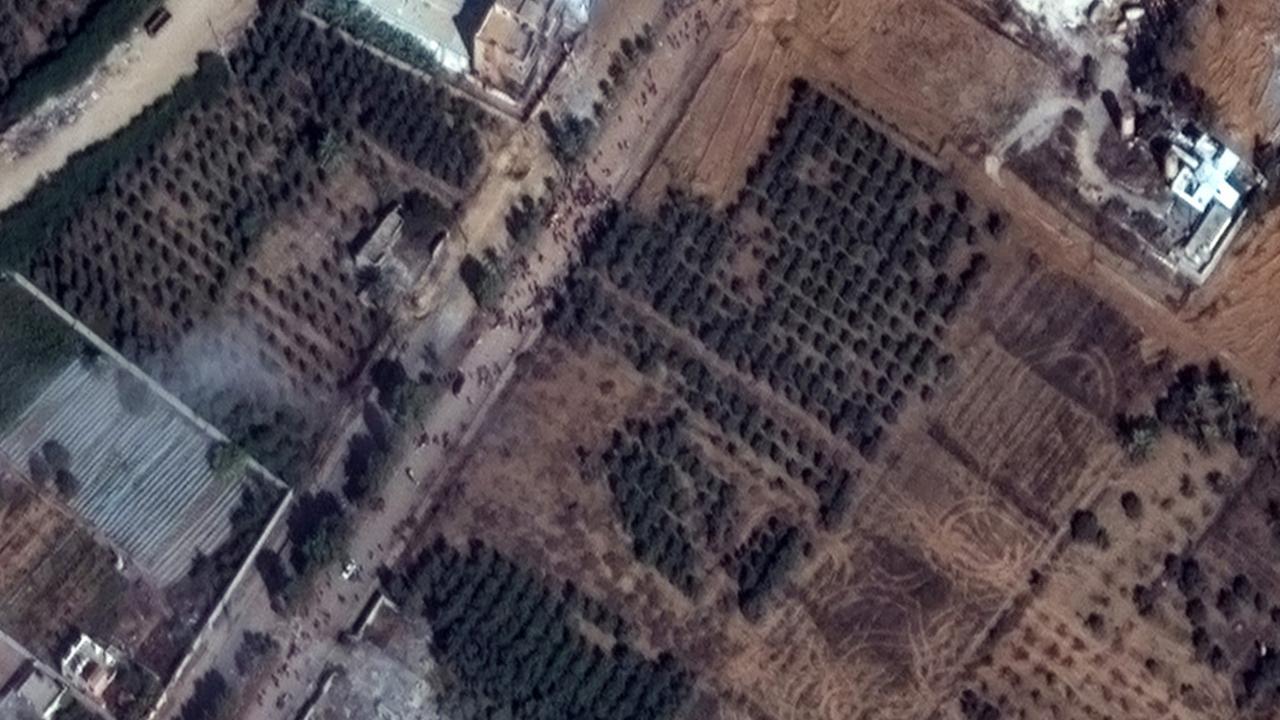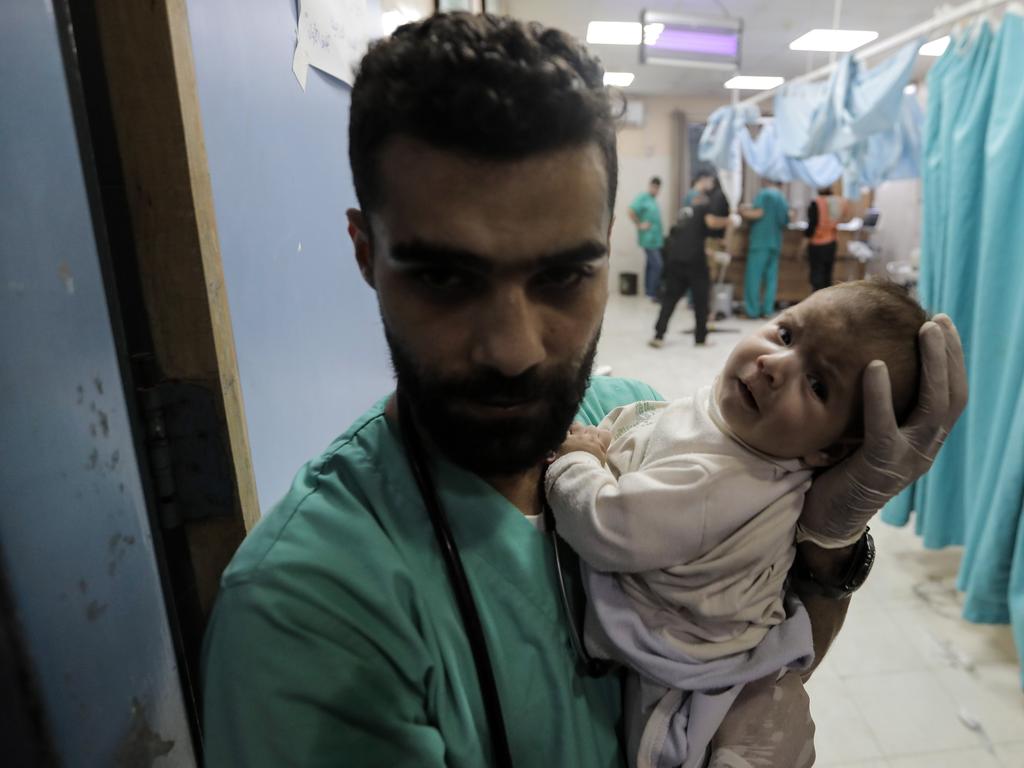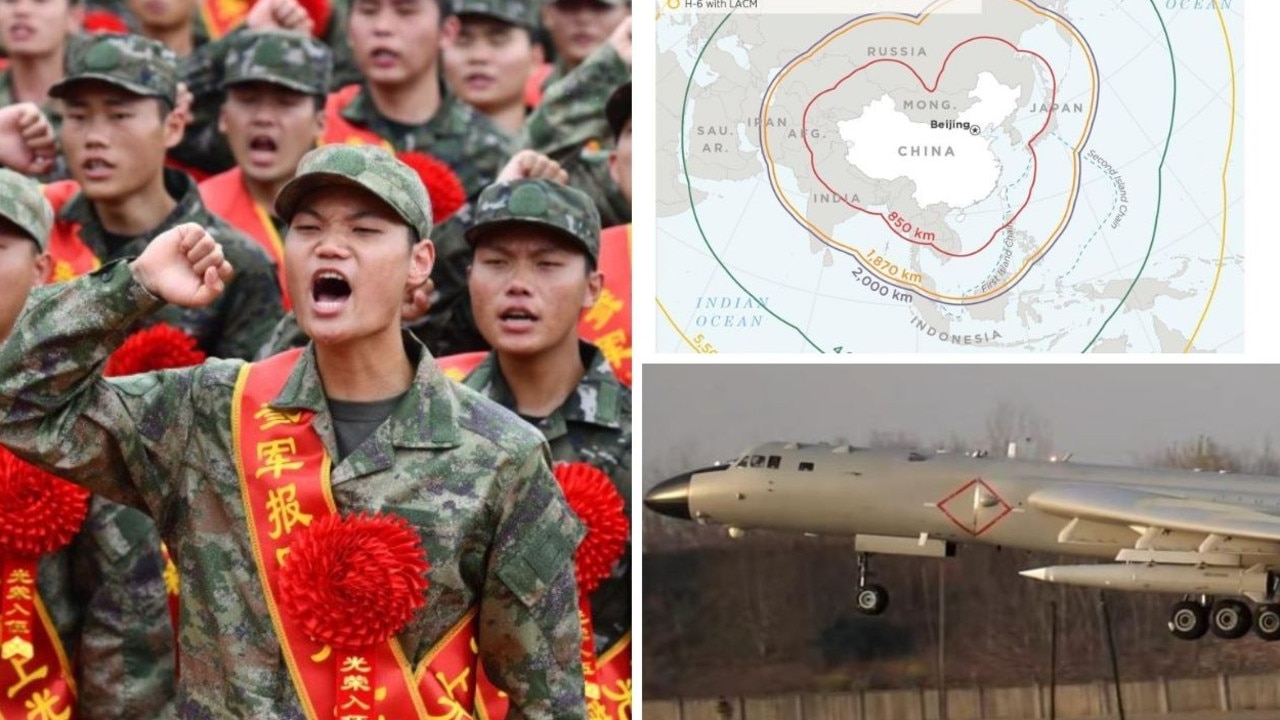Pictures show ‘shattering’ destruction of Gaza visible from space
Satellite photos and video footage have captured the terror for Palestinians as they try to flee danger as Israel continues heavy bombardment.

ANALYSIS
Israel has ordered Palestinians in northern Gaza to evacuate again. At the same time, it’s ordering refugees already in southern Gaza to flee – somewhere else. And the panicked response can be seen from space.
Now, Maxar Technology’s commercially available satellite photos reveal thousands of Palestinians are once again streaming across a blasted landscape of ruined buildings and devastated infrastructure in search of safety.
They’re walking down Gaza’s main north-south thoroughfare, Salah al Deen Road. They’re trying to escape the rubble of Gaza City and the Jabalia refugee camp.
They’re being stopped by Israeli soldiers to be scanned one by one by facial ID software at a makeshift shipping container checkpoint.

Meanwhile, new video footage (see above) is seeping out amid the extended communications blackout surrounding this unfolding exodus. It adds a human perspective to the satellite overview.
People are pushing wheelchairs with evicted hospital patients among mothers hauling overloaded prams. A few donkey-hauled carts are the only permitted non-human means of transportation.
They’re doing what they can to comply with Israel’s demands.
The southern half of the 360 sqkm Gaza Strip was designated a refugee zone by Israel as it launched its armoured assault in response to the October 7 terror attack by Hamas.
Up to a million Palestinians have already responded to Israel’s orders to move south.
But that refuge has itself been subjected to heavy bombardment.

Now Israeli aircraft are reportedly dropping leaflets across southern Gaza, telling evacuees and residents to evacuate once again – this time to unspecified “safer” locations. They warn anyone remaining in the path of fresh Israeli military operations will be putting their own lives “in danger”.
One of the leaflet drop targets is the town of Khan Younis, just 9km north of the closed Rafah border crossing with Egypt. Refugees seeking safety there have no further south to flee.
“They asked us, the citizens of Gaza, to go to the south. We went to the south. Now they are asking us to leave. Where do we go?” refugee Atya Abu Jab told a Reuters reporter last night.
Struggle to survive
United Nations analysis of satellite photos and the reports of its humanitarian workers reveal Israel has been unleashing aircraft and artillery assaults against south Gaza daily.
It believes more than 3600 Palestinians have been killed in the areas Israel had ordered North Gazans to flee to. That’s about one-third the total Palestinian death toll.
The IDF media unit says this is because “Hamas has embedded itself in civilian infrastructure and operates across the entire Gaza Strip”. And it insists any association with Gaza’s 17-year-old Hamas government defines a legitimate target.
New comprehensive satellite imagery-based damage assessment over the #Gaza Strip as of 7 November.
— UNOSAT (@UNOSAT) November 15, 2023
The satellite imagery-based analysis shows a significant increase of approximately 137% in the total number of damaged buildings.
â–¶ï¸https://t.co/XAyTURhz3apic.twitter.com/YHx63nTaK1
Ongoing analysis of European Space Agency Sentinel-1 Earth Observation data reveals more than 10,000 buildings in the evacuation zone appear to have been hit so far. And about 6000 of those strikes happened before October 28.
Last week, Israel attacked population centres in the evacuation zone, including Khan Younis and the refugee camps of Bureij, Nuseirat, Deir- al-Balah and Al-Maghazi.
The UN says some 830,000 refugees people are seeking safety in south-Gaza UN Relief Agency schools and service buildings. More than 64 of these facilities have been bombed so far. And it’s not just Palestinians being killed.
“Every day we get more confirmation of more colleagues killed,” says Juliette Touma, UNRWA director of communications Juliette Touma. “It’s shattering. It’s just shattering.”
On Saturday, an apartment block in Khan Younis was hit. Some 26 residents were reportedly killed.

IDF spokesman Rear Admiral Daniel Hagari responded by insisting Israeli troops would strike “wherever Hamas exists, including in the south of the strip. We are determined to advance our operation”.
And the recent repositioning of Israeli troops and tanks suggests it is preparing to launch a ground attack into southern Gaza.
Meanwhile, Egypt is sticking to its guns. It says it refuses to “solve Israel’s problem for it” by enabling a new Nakbah – or permanent eviction of Palestinian residents of the Holy Land – by allowing them to cross into its territory.
‘We are too humane’
On October 13, Prime Minister Benjamin Netanyahu’s government promised Palestinians that everywhere south of a narrow swamp – the Wadi Gaza wetlands – would be spared.
On October 28, the IDF unleashed its ground invasion of Gaza City – insisting it would strike what it believes to be Hamas targets “wherever necessary” to “protect the security of the state of Israel”.
Yesterday, Prime Minister Netanyahu admitted his troops were taking a heavy toll on Palestinian civilians. But he insists it is entirely Hamas’ fault.
“That’s what we’re trying to do – minimal civilian casualties. But unfortunately, we’re not successful,” Netanyahu told US media.

However, his coalition government’s minister for security was less measured with his words. In an Israeli television interview last week, he declared: “We are now rolling out the Gaza Nakba.”
Nakba means catastrophe. It’s a term used to remember the forced eviction of more than 750,000 Palestinians from their homes in 1948, shortly after a UN vote mandated the creation of separate Israeli and Palestinian states. The refugee camps built in Gaza, the West Bank, Lebanon, Syria and Jordan to house these evictees have since turned into ramshackle cities. And – 75 years after the first Nakba – their descendants are still determined to return home.
Jordan’s foreign minister Ayman Safadi says his kingdom will do “whatever it takes to stop” a repeat Nakba. “We will never allow that to happen; in addition to it being a war crime, it would be a direct threat to our national security,” he said yesterday.
Israel’s deputy speaker of the Knesset (parliament), however, believes Israel has been too soft on Gaza’s residents.
“All of this preoccupation with whether or not there is internet in Gaza shows that we have learned nothing. We are too humane,” Nassim Baturi wrote on social media. “Burn Gaza now, nothing less! Don’t allow fuel in; don’t allow water in until the hostages are returned!”
Saudi Arabia’s foreign minister, Prince Faisal bin Farhan, rejected this sentiment: “We are seeing civilians dying every day. And we need to end that today, not tomorrow.”
Jamie Seidel is a freelance writer | @JamieSeidel






